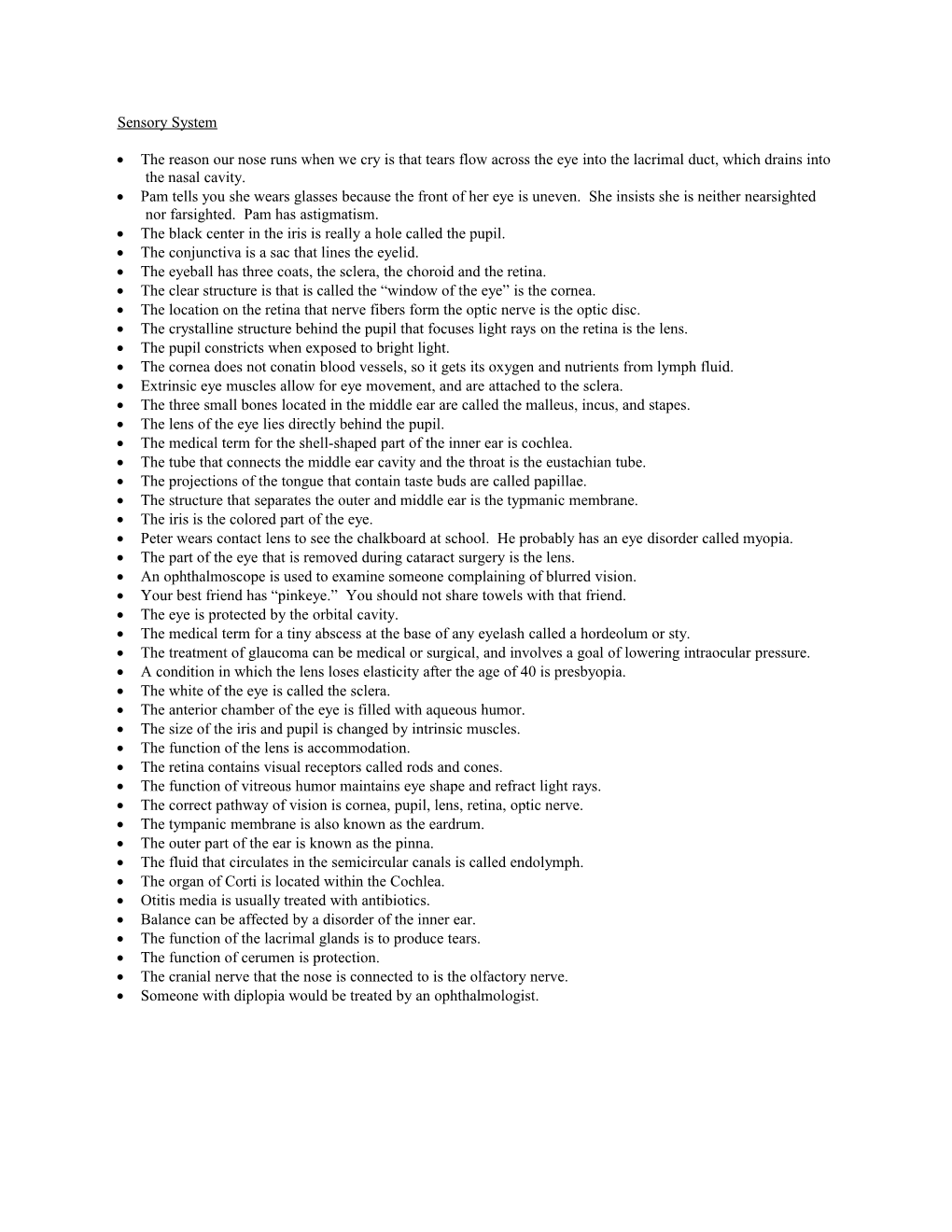
Sensory System
- The reason our nose runs when we cry is that tears flow across the eye into the lacrimal duct, which drains into the nasal cavity.
- Pam tells you she wears glasses because the front of her eye is uneven. She insists she is neither nearsighted nor farsighted. Pam has astigmatism.
- The black center in the iris is really a hole called the pupil.
- The conjunctiva is a sac that lines the eyelid.
- The eyeball has three coats, the sclera, the choroid and the retina.
- The clear structure is that is called the “window of the eye” is the cornea.
- The location on the retina that nerve fibers form the optic nerve is the optic disc.
- The crystalline structure behind the pupil that focuses light rays on the retina is the lens.
- The pupil constricts when exposed to bright light.
- The cornea does not conatin blood vessels, so it gets its oxygen and nutrients from lymph fluid.
- Extrinsic eye muscles allow for eye movement, and are attached to the sclera.
- The three small bones located in the middle ear are called the malleus, incus, and stapes.
- The lens of the eye lies directly behind the pupil.
- The medical term for the shell-shaped part of the inner ear is cochlea.
- The tube that connects the middle ear cavity and the throat is the eustachian tube.
- The projections of the tongue that contain taste buds are called papillae.
- The structure that separates the outer and middle ear is the typmanic membrane.
- The iris is the colored part of the eye.
- Peter wears contact lens to see the chalkboard at school. He probably has an eye disorder called myopia.
- The part of the eye that is removed during cataract surgery is the lens.
- An ophthalmoscope is used to examine someone complaining of blurred vision.
- Your best friend has “pinkeye.” You should not share towels with that friend.
- The eye is protected by the orbital cavity.
- The medical term for a tiny abscess at the base of any eyelash called a hordeolum or sty.
- The treatment of glaucoma can be medical or surgical, and involves a goal of lowering intraocular pressure.
- A condition in which the lens loses elasticity after the age of 40 is presbyopia.
- The white of the eye is called the sclera.
- The anterior chamber of the eye is filled with aqueous humor.
- The size of the iris and pupil is changed by intrinsic muscles.
- The function of the lens is accommodation.
- The retina contains visual receptors called rods and cones.
- The function of vitreous humor maintains eye shape and refract light rays.
- The correct pathway of vision is cornea, pupil, lens, retina, optic nerve.
- The tympanic membrane is also known as the eardrum.
- The outer part of the ear is known as the pinna.
- The fluid that circulates in the semicircular canals is called endolymph.
- The organ of Corti is located within the Cochlea.
- Otitis media is usually treated with antibiotics.
- Balance can be affected by a disorder of the inner ear.
- The function of the lacrimal glands is to produce tears.
- The function of cerumen is protection.
- The cranial nerve that the nose is connected to is the olfactory nerve.
- Someone with diplopia would be treated by an ophthalmologist.
